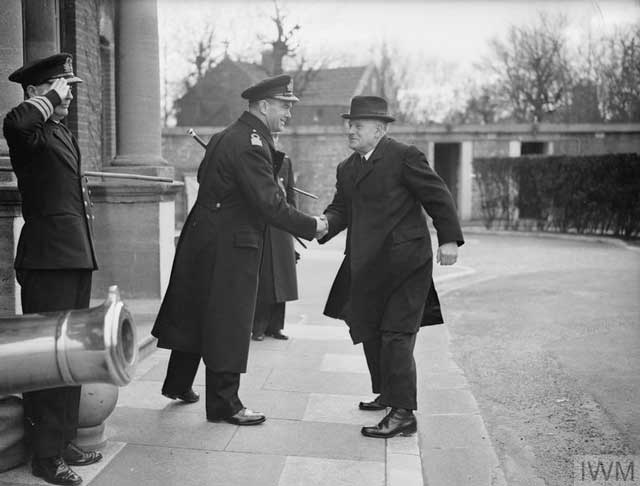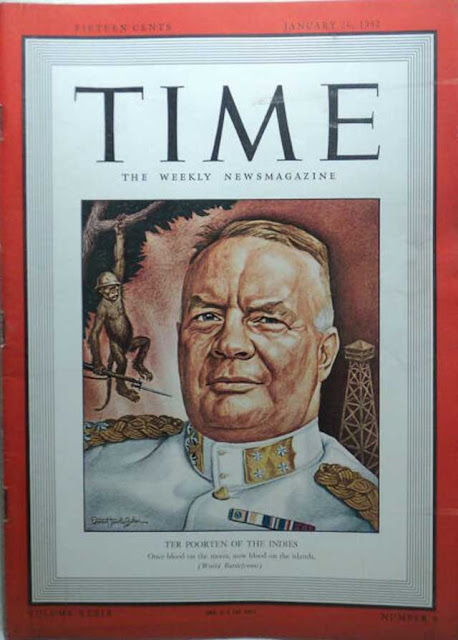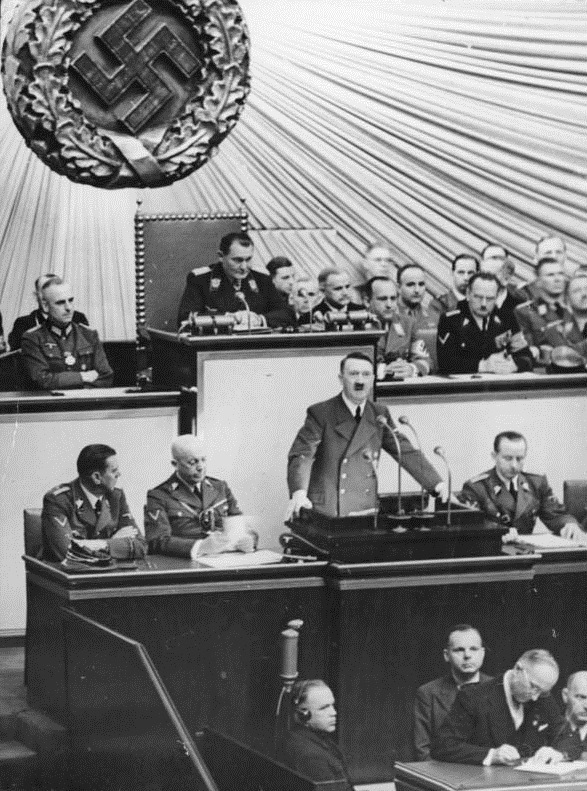Anglo-Iraq War: The British on
4 May 1941 continue their successful defense of Habbaniyah Airfield, Basra and their other fortified positions in Iraq. The RAF has complete control of the air. British reinforcements, called "Iraqforce," are now on the march to Iraq from Palestine and Transjordan (Habforce and Kingcol), while men are trickling into Basra from India. The motley group of British ground forces in Habbaniyah already are having some success forcing the Iraqis back toward Baghdad, suggesting they will be able to hold out until the relief arrives.
The RAF raids the Iraqi forces, including Baghdad (where it drops leaflets) and other enemy areas. The Luftwaffe has a small presence at Mosul Airfield for receiving supplies via Vichy Syria, which the RAF also attacks.
There still is Iraqi resistance at Basra, where Iraqi gunboats and merchantmen remain outside of British control. Australian sloop HMAS Yarra arrives there today to help deal with the Iraqi shipping.
 |
| A Messerschmitt Bf 110D3 Zerstorer IAF 4.ZG76 in Iraqi markings, Mosul Iraq May 1941. |
European Air Operations: The Luftwaffe continues bombing Liverpool. The May Blitz is notable for its ferocity and accuracy. The Germans have refined their techniques and finally are targeting port infrastructure and vulnerable shipping in the harbor with great success. The aftereffects of the devastating explosion of 7649-ton ammunition ship Malakand on the 3rd continue to be felt there, and 295-ton ship Pneumatic Elevator No. 11 sinks due to the blast effects, adding to the numerous ships sunk or damaged. Other ships damaged today by the Luftwaffe include:
- 274-ton tug Bison
- 10,254-ton liner Talthybius
- 7005-ton freighter Baron Inchcape
- 201-ton tug Hornby
- 99-ton tug Enid Blanche
- 719-ton hopper barge No. 33
- 209-ton barge Aid
- 67-ton flat John
- 46-ton sailing barge Bongo
- 7801-ton freighter Roxburgh Castle.
Some of the ships are repaired, but others are hit in subsequent raids and destroyed. The port is devastated and in chaos, with many ships on fire, others slowly sinking, and new ships still being docked and unloaded. There are separate attacks by 55 bombers targets Barrow-in-Furness, and 17 bombers on Hartlepool, with a small force hitting Middlesbrough. The Germans lose a couple of Junkers Ju 88s, one to engine failure, another to a night fighter.
The Luftwaffe also bombs Belfast with 204 aircraft. This is the third attack of the "Belfast Blitz," the first two attacks occurring on 7 and 15 April 1941. In today's attack, 150 people are killed by the many incendiaries dropped by the Germans. The Germans believe that this is one of England's "hiding places" where it is hiding vast stocks of war material. Hitler, however, is beginning to have doubts about the wisdom of attacking Ireland, reasoning that the strong Irish influence in the United States might lead to US entry into the war.
The British in Liverpool are reeling. They evacuate the Liverpool North End Unitarian Mission shelter, where Reverend Charles A Piper has been keeping a diary as he runs the shelter. The diary, which concludes with the 4 May 1941 entry, remains a valuable primary source on the May Blitz.
RAF Bomber Command raids the port of Brest with 97 bombers, and also sends a dozen aircraft to attack shipping.
The Luftwaffe continues to upgrade its equipment, with Bf 109F fighters beginning to appear. Kommodore Mölders of JG 51, the leading ace of the war to date, shoots down a Hawker Hurricane of RAF No. 601 Squadron in the new plane.
 |
| Joseph Goebbels and Joachim Ribbentrop give the Hitler Salute at the 4 May 1941 speech by Adolf Hitler at the Kroll Opera House (Federal Archives). |
East African Campaign: The 5th Indian Division, which has been advancing from the south, attacks the Italian positions at Amba Alagi. The Italians, though somewhat distracted by a separate attack coming up the Falaga Pass, are dug in and give little ground. The Gold Coast 24th Infantry Brigade attacks Italian positions at Wadara in Galla-Sidamo, while the Indian troops at Amba Alagi do capture a few foothills (Pyramid, Whale Back, and Elephant ). From here the going becomes steeper and more open to Italian fire.
Another British force is heading south toward the city, with a third force, the South Africans, also approaching. The Italians, meanwhile, are hiding out in caves which are very defensible, but also have no access to resupply and scant stores of even the most basic necessities such as food and water.
Battle of the Atlantic: U-38 (Kptlt. Heinrich Liebe), operating out of Lorient on her 9th and most successful patrol, is off of Freetown in the Atlantic when it fires three torpedoes and uses its deck gun to sink 5230-ton Swedish freighter Japan. The entire 55-man crew (and four passengers) makes land and survives, but is captured and interned by the Vichy French. The ship is part of Convoy OB-310. The U-38's deck gun explodes, injuring the gun crew.
The Luftwaffe hits 234-ton minesweeping trawler HMT Ben Gairn with a parachute mine at Waveney Dock, Lowestoft, Suffolk. There are no casualties, but the ship is destroyed.
The Luftwaffe bombs and sinks 222-ton British freighter Tregor off Trevose Head. The six-man crew survives.
The Luftwaffe also damages 545-ton Belgian freighter Marie Flore off Trevose Head. Marie Flore tries to make it to port but cannot get there and is beached at Padstow.
The Luftwaffe also damages destroyer HMS Southdown in the North Sea by a near miss. The ship is leaking and temporarily loses steering but makes it to port.
The Luftwaffe damages minesweeper Selkirk and patrol yacht HMY Franc Tireur in the Thames Estuary. Both ships make it back for repairs.
Royal Navy minesweeper HMS Latona (Captain Stuart L. Bateson) is commissioned.
Battle of the Mediterranean: German General Paulus, temporarily in command of the Afrika Korps, seen enough of the abortive attack on Tobruk. He orders that no more attacks be made by Rommel's forces unless there are signs of Allied retreat. Paulus already is looking toward his rear and orders that a new defensive line must be built in Gazala. In this sense, he is basically in agreement with the failed Italian strategy which began the campaign, believing in the value of fixed defensive positions in the defensive rather than Rommel's faith in mobile operations. Rommel dutifully begins constructing defensive outposts facing the Tobruk perimeter. From this point forward for the next couple of months, the Germans and Australians will engage in only local actions, with the Germans holding their small three-mile wide incursion into Tobruk's defenses.
The campaign evolves into competing supply buildups between Germany and Great Britain, with both sides holding unique advances in that struggle (the Royal Navy largely controls the sea and can be supplied from India, Australia, and New Zealand in addition to England, while the Axis has a short, though dangerous, supply route from Italy).
Churchill cables his Middle East commander General Archibald Wavell in Cairo. He states that is is "most important not to allow fighting around Tobruk to die down" due to the Germans' over-extension following his "premature audacious advance." He encourages counterattacks "at the earliest possible moment" to prevent the Afrika Korps from being able to "gather supplies and strength for a forward move." Churchill and Paulus, thus, see the North Africa campaign developing the same way, and this is not a coincidence, as the British are reading the German codes via the Ultra decryption program.
Churchill also notes in his cable the "success of Demon." This is a reference to Operation Demon, a daring gamble of running disguised freighters directly through the Mediterranean to Egypt. In fact, one Demon ship already has been sunk, though two have made it through.
New Zealand Major-General Bernard Freyberg, the British leader in Crete, is feeling a bit exposed now that the Germans have had some time to digest the Greek mainland. He asks Wavell for permission to evacuate about 10,000 men who are refugees from the mainland and, by and large, unarmed. He notes that they have "little or no employment other than getting into trouble with the civil population."
The Germans occupy the Greek islands of Lesbos and Chios.
Italian torpedo boat Giuseppe La Farina hits a mine and sinks off Kerkennah. The Italians are busy supplying the Afrika Korps in Tripoli and today send a convoy of seven troopships from Naples. The Italians provide a heavy escort three light cruisers and 8 destroyers, with some smaller torpedo boats also involved.
At Malta, the Luftwaffe remains active. Minesweeper HMS Fermoy, which was damaged earlier in the month and under repair, sinks from its damage.
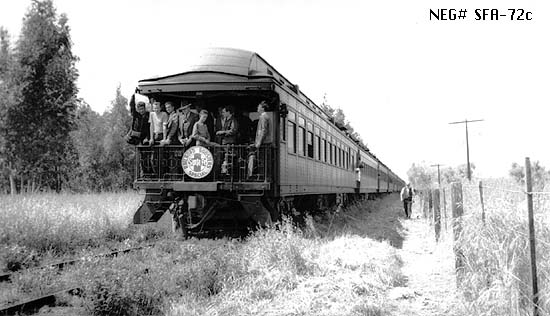 |
| Santa Fe Excursion train, 4 May 1941. |
War Crimes: The Luftwaffe damages 7117-ton hospital ship Karapara in Tobruk Harbour. While accidents happen, hospital ships are clearly marked and there have been many incidents involving them. The Karapara makes it to Port Said for repairs. While there may seem little to gain by attacking hospital ships, driving them off or destroying them isolates the Australians holding out in Tobruk.
Anglo/US Relations: Churchill cables President Roosevelt and suggests that the Royal Navy is seriously considering occupying the Canary Islands (which he never actually names) and other Portuguese islands in the Atlantic in order to forestall a Wehrmacht occupation there. The US, he proposes, would serve as the "guarantor" that those islands would be returned to Portugal after the war. He also notes that "We are determined to fight to the last inch and ounce for Egypt, including its outposts of Tobruk and Crete."
Anglo/Portuguese Relations: Perhaps coincidental to Churchill's cable to President Roosevelt (but perhaps not), Australian Prime Minister Robert Menzies, on his way to New York, calls on Portuguese Prime Minister Dr. Salazar in Lisbon. Salazar, Menzies writes in his diary, is "very sincere and earnest" and tells Menzies that "The Portuguese won't fight." Of course, the Portuguese are in no danger so long as Spain remains neutral, though Hitler still dreams of drawing Franco into his collection of satellites and then occupying Portugal and its Atlantic islands.
German Military: While Adolf Hitler already has set the date for Operation Barbarossa as 22 June 1941, not everyone agrees with the decision. In fact, there is little enthusiasm for it within the uppermost reaches of the German government and military, including by Luftwaffe boss Hermann Goering. Admiral Raeder continues to press for his "peripheral strategy," which focuses on cutting off Great Britain's overseas possessions in the Mediterranean and elsewhere. That strategy to date has had great success, but the British remain entrenched in Egypt and at Gibraltar. The vast mass of the Wehrmacht, however, already is positioned in the East, and Hitler sticks with his plan to invade the Soviet Union.
 |
| Franklin Delano Roosevelt attends the dedication ceremony for the Home of Woodrow Wilson. Staunton, VA, May 4, 1941. FDR gives a speech on "The Power of Spiritual Force" (Margaret Suckley, FDR Presidential Library and Museum). |
US Military: Brig. Gen. Henry B. Clagett, with his chief of staff Col. Harold Huston George, arrive at Manila in the Philippines to command the newly created Philippine Department Air Force. They arrive on a Boeing 314 Clipper (Pan-American Air Lines). Their mission is to expand the air defenses in the Philippines.
Soviet Government: The Politburo replaces Foreign Minister Vyacheslav Molotov with Joseph Stalin as Chairman of the Council of People's Commissars. This makes Stalin the
de jure head of the Soviet government These appointments in the USSR are mere formalities, though, as there is no question that Stalin runs the government and always is the
de facto national leader.
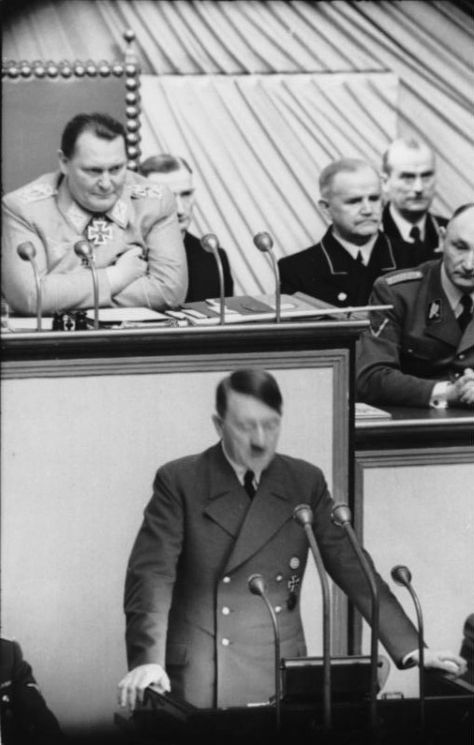 |
| Hitler and Goering on 4 May 1941. |
German Government: Adolf Hitler
addresses the Reichstag in the Kroll Opera House (the Reichstag building itself has been unusable since the infamous fire several years ago). As often happens during his wartime speeches, Hitler sums up past events rather than giving a specific preview of coming events. In essence, it is a victory speech and covers events from the beginning of the war to date.
Hitler digs deep, delivering a polemic on why Germany is at war that is based on equal parts paranoia, self-delusion, and outright fabrications. He propounds some of his standard themes - that Germany was forced into the war based on decisions taken by others "as early as 1936," that the plot against Germany was formed by "great international Jewish financial interests," and that "this criminal" Winston Churchill (he also terms him a "fool" and a "drunkard") was personally responsible for the blockade and aerial campaign against the Reich.
Hitler also puts forth an economic argument for German policy in the Balkans - which obviously involves a lot of Wehrmacht military activity. He argues that reliance on money, or "worthless democratic money paper" as he puts it, is inherently unfair, and only mutual trade agreements such as those between the Reich and the Balkan states is fair. The wars that Germany has just won were the product of "filthy British politics" which had duped Romania, Yugoslavia, and Greece and had forced a defensive campaign by the Wehrmacht to protect its southeast flank.
Hitler summarizes the Greek Campaign (Operation Marita) by claiming that Churchill had committed "one of the greatest strategic blunders of this war" by trying to garrison and defend it. He credits the order to attack Yugoslavia to the coup there. He notes that "the Greek soldiers have fought with the greatest bravery and contempt of death," and that the British force in Greece was there to attack the Reich and thus had to be removed. He gives figures of 57 officers and 1042 noncommissioned officers and men killed, 181 officers and 3571 noncommissioned officers and men wounded, and 13 officers and 372 noncommissioned officers and men wounded. Regarding future operations, he merely states that he views them with "perfect tranquillity and great confidence."
Needless to say, the speech is pure propaganda. Churchill's belated and inadequate military aid to Greece turned out to do nothing but offer Hitler a convenient excuse for why he attacked. No mention is made in the speech, of course, of Hitler's intense preparations for invading Greece long before the first British boot set foot there.
Singapore: Winston Churchill asks General Ismay for a "report on the efficiency of the gunners and personnel" manning air defenses in Singapore.
Romania: Madeleine Cantacuzino (soon to be Madeleine Lipatti) and Dinu Lipatti gave the first Romanian performance of Lipatti’s Symphonie concertante for two pianos and strings.
American Homeland: There is a concert held for the Deutsches Kriegshilfswerk [German war workers] at the California Hall in San Francisco, California. There is a strong German presence in San Francisco, where the Germans maintain a consulate.
Future History: Nickolas Ashford is born in Fairfield, South Carolina. He will become half of the famous singing group Ashford & Simpson. He will pass away in 2011.
 |
| Baseball in San Bruno Park, California on May 4, 1941 (Fred Beltramo, San Bruno Public Library). |
May 1941 May 1, 1941: British Hold TobrukMay 2, 1941: Anglo-Iraq WarMay 3, 1941: Liverpool HammeredMay 4, 1941: Hitler Victory SpeechMay 5, 1941: Patriots DayMay 6, 1941: Stalin In CommandMay 7, 1941: May BlitzMay 8, 1941: Pinguin SunkMay 9, 1941: U-110 CapturedMay 10, 1941: Hess Flies Into HistoryMay 11, 1941: The Hess Peace PlanMay 12, 1941: Tiger Arrives SafelyMay 13, 1941: Keitel's Illegal OrderMay 14, 1941: Holocaust in ParisMay 15, 1941: Operation BrevityMay 16, 1941: Blitz EndsMay 17, 1941: Habbaniya RelievedMay 18, 1941: Croatia PartitionedMay 19, 1941: Bismarck at SeaMay 20, 1941: Invasion of CreteMay 21, 1941: Robin Moore SinkingMay 22, 1941: Royal Navy Destruction Off CreteMay 23, 1941: Crete Must Be WonMay 24, 1941: Bismarck Sinks HoodMay 25, 1941: Lütjens' Brilliant ManeuverMay 26, 1941: Bismarck StoppedMay 27, 1941: Bismarck SunkMay 28, 1941: Crete LostMay 29, 1941: Royal Navy Mauled Off CreteMay 30, 1941: Sorge Warns, Stalin IgnoresMay 31, 1941: British Take Baghdad2020





